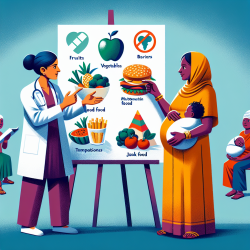Introduction
As practitioners dedicated to improving child outcomes, understanding the nuances of maternal nutrition is essential. The research article titled "Addressing barriers to maternal nutrition in low- and middle-income countries: A review of the evidence and programme implications" by Kavle and Landry provides valuable insights into the barriers and opportunities for enhancing maternal nutrition. This blog post aims to translate these findings into actionable strategies for practitioners working in speech-language pathology and related fields.
Understanding the Barriers
The research highlights several barriers to adequate maternal nutrition during pregnancy and lactation, particularly in low- and middle-income countries. These barriers include:
- Cultural Beliefs: Misconceptions about the appropriate quantity of food and weight gain during pregnancy can lead to inadequate nutrition.
- Food Restrictions: Cultural taboos and beliefs about certain foods being inappropriate during pregnancy or lactation contribute to dietary limitations.
- Economic Constraints: Limited household food availability and financial resources can impede access to nutritious foods.
Implementing Evidence-Based Strategies
Practitioners can play a pivotal role in addressing these barriers by implementing evidence-based strategies. Here are some recommendations based on the research findings:
- Culturally Tailored Education: Develop nutrition education programs that resonate with cultural beliefs and practices. This involves engaging with community leaders and influencers to promote positive dietary changes.
- Comprehensive Counseling: Provide counseling on maternal diet and weight gain during pregnancy. Tailored advice can help dispel myths and encourage healthier eating habits.
- Monitoring and Support: Establish systems to monitor maternal nutrition progress and provide ongoing support. This could involve regular check-ins and the use of technology to track dietary habits.
Encouraging Further Research
While the research provides a solid foundation, there is a need for continued exploration into maternal nutrition. Practitioners are encouraged to engage in further research to understand the specific needs of their communities and to develop innovative solutions. Collaborating with local universities and research institutions can enhance the quality and reach of such initiatives.
Conclusion
By addressing the barriers to maternal nutrition and implementing culturally sensitive strategies, practitioners can significantly improve maternal and child health outcomes. This aligns with our commitment to data-driven decision-making and evidence-based practice.
To read the original research paper, please follow this link: Addressing barriers to maternal nutrition in low- and middle-income countries: A review of the evidence and programme implications.










